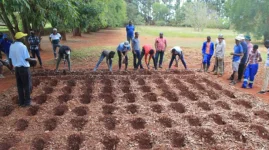Many farmers might want to forget the tough, dry spell at the start of the farming season. Smart farmers should instead learn from these challenges to prepare for future problems. Those who planted early crops with October and November rains hoped to beat the predicted below-normal rainfall caused by La Nina weather patterns. Most farmers these days try to plant crops at different times to save something when the weather turns bad.
Early planting helps test what kind of season lies ahead. Sometimes, these test crops become the main food source for families when rain only falls at the beginning before stopping completely. No smart person stands still when danger comes their way. Farmers must act to protect their work and investments from harsh weather rather than watching everything die. They need to use what they learned from recent dry spells to make better plans for coming seasons.
Farmers should consider how much water their crops need during different growth stages. Water shortages affect crops less during early growth compared to later maturity stages. Poor soil moisture after planting can prevent seeds from growing properly, leading to weak plants and lower yields. The current situation shows why understanding early-season dry spells matters. Some farmers have young crops after replanting, others have nearly mature plants, and a few are already harvesting.
Different results show how various groups handled the season start. Farmers using Pfumvudza conservation methods did better during dry times. Those with irrigation systems continued as usual unless their water sources dried up. Every farmer should collect rainwater whenever heavy storms create runoff. This stored water helps crops survive tough periods and stabilizes yields when normal rainfall stops. Putting mulch around plants traps moisture and stops weeds from stealing water from the soil.
Conservation farming methods give better chances of harvesting something even during difficult seasons. When controlling weeds, farmers should disturb the soil as little as possible. This protects crops by reducing competition for scarce moisture. If seeds fail to grow because of dry conditions, farmers might need to fill gaps or replant entirely. Many areas still allow planting into December or January depending on local conditions. With weather problems becoming more common, farmers must include prevention measures when planning their seasons.
Planning should include both crops and animals. Many livestock died recently because owners failed to prepare backup options. These cattle deaths remind farmers they need emergency feed supplies ready. Water collection and storage systems matter greatly for animals. Livestock suffer from heat stress easily, which causes lower production, fertility problems, and more diseases. Animals need plenty of water during hot periods to stay healthy and productive.
These ideas represent just some ways farmers can handle dry spells better. Many decisions depend on specific situations and should consider current conditions and weather forecasts. Farmers benefit from expert advice from agricultural extension officers or crop specialists. Regular updates from official sources like the Meteorological Services Department help make smarter farming choices. Taking action before problems hit makes the difference between harvesting something or nothing at all.
Early planting helps test what kind of season lies ahead. Sometimes, these test crops become the main food source for families when rain only falls at the beginning before stopping completely. No smart person stands still when danger comes their way. Farmers must act to protect their work and investments from harsh weather rather than watching everything die. They need to use what they learned from recent dry spells to make better plans for coming seasons.
Farmers should consider how much water their crops need during different growth stages. Water shortages affect crops less during early growth compared to later maturity stages. Poor soil moisture after planting can prevent seeds from growing properly, leading to weak plants and lower yields. The current situation shows why understanding early-season dry spells matters. Some farmers have young crops after replanting, others have nearly mature plants, and a few are already harvesting.
Different results show how various groups handled the season start. Farmers using Pfumvudza conservation methods did better during dry times. Those with irrigation systems continued as usual unless their water sources dried up. Every farmer should collect rainwater whenever heavy storms create runoff. This stored water helps crops survive tough periods and stabilizes yields when normal rainfall stops. Putting mulch around plants traps moisture and stops weeds from stealing water from the soil.
Conservation farming methods give better chances of harvesting something even during difficult seasons. When controlling weeds, farmers should disturb the soil as little as possible. This protects crops by reducing competition for scarce moisture. If seeds fail to grow because of dry conditions, farmers might need to fill gaps or replant entirely. Many areas still allow planting into December or January depending on local conditions. With weather problems becoming more common, farmers must include prevention measures when planning their seasons.
Planning should include both crops and animals. Many livestock died recently because owners failed to prepare backup options. These cattle deaths remind farmers they need emergency feed supplies ready. Water collection and storage systems matter greatly for animals. Livestock suffer from heat stress easily, which causes lower production, fertility problems, and more diseases. Animals need plenty of water during hot periods to stay healthy and productive.
These ideas represent just some ways farmers can handle dry spells better. Many decisions depend on specific situations and should consider current conditions and weather forecasts. Farmers benefit from expert advice from agricultural extension officers or crop specialists. Regular updates from official sources like the Meteorological Services Department help make smarter farming choices. Taking action before problems hit makes the difference between harvesting something or nothing at all.












